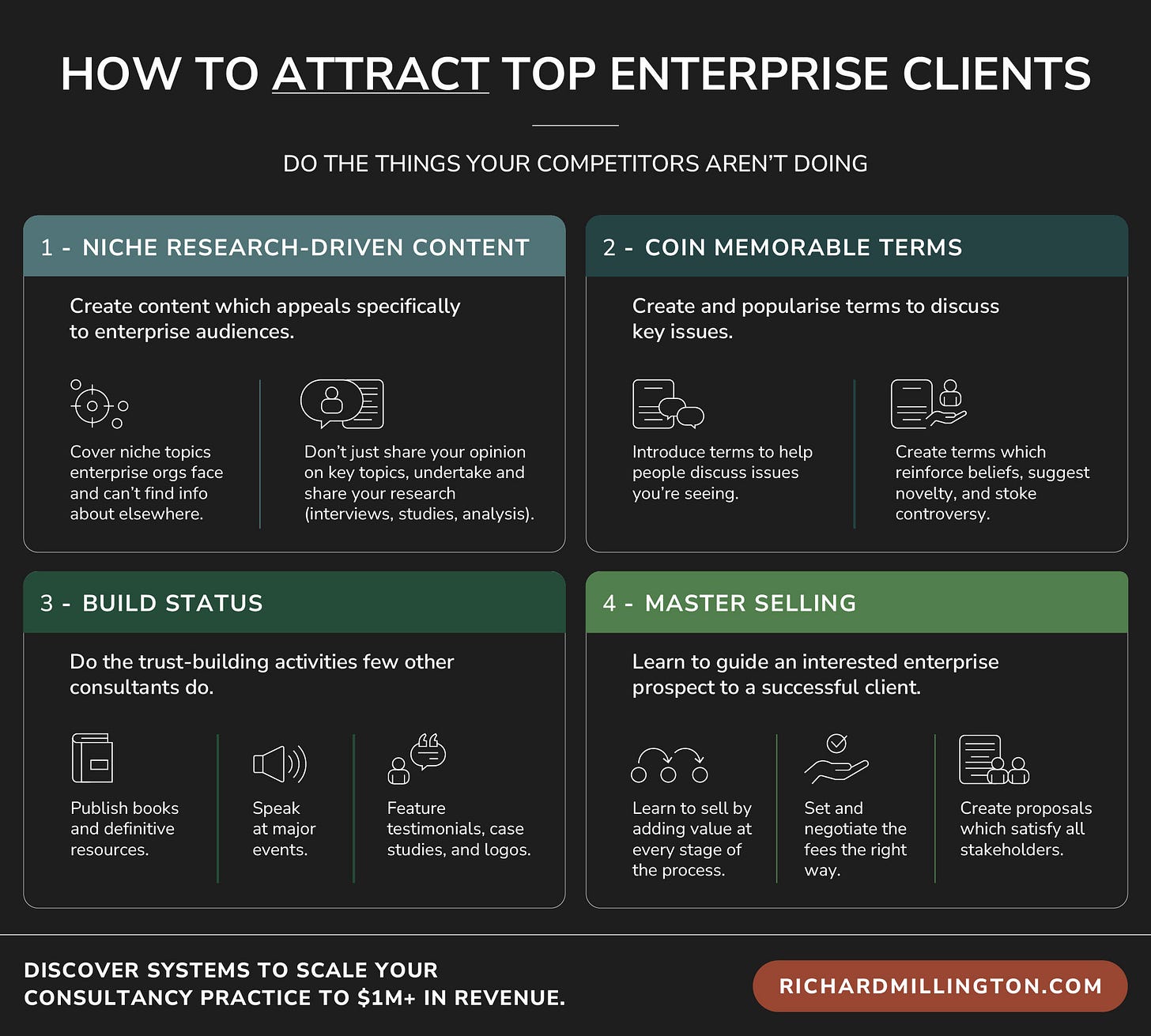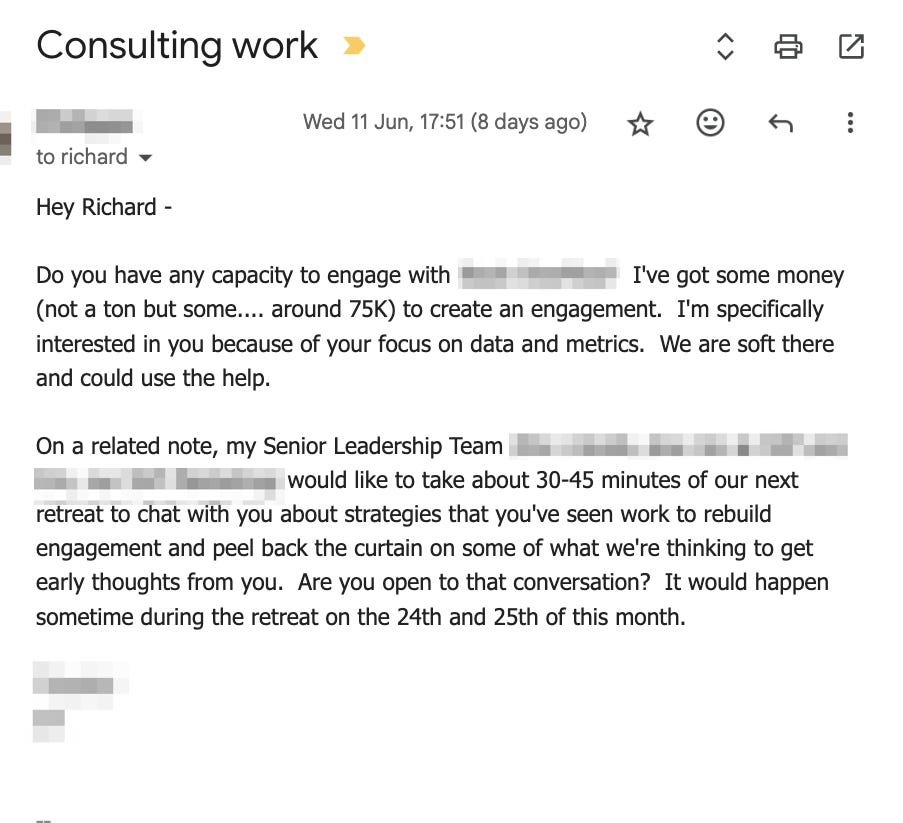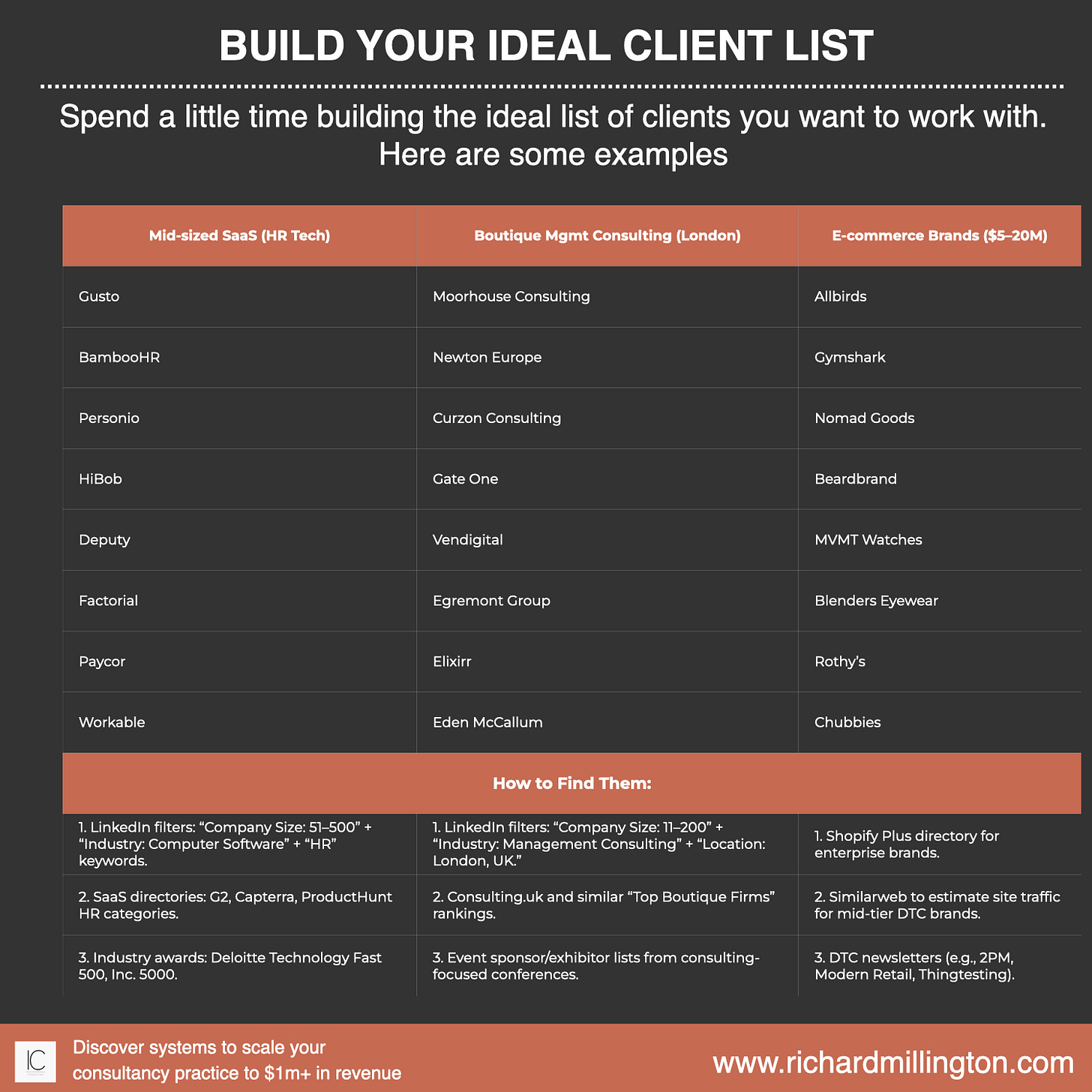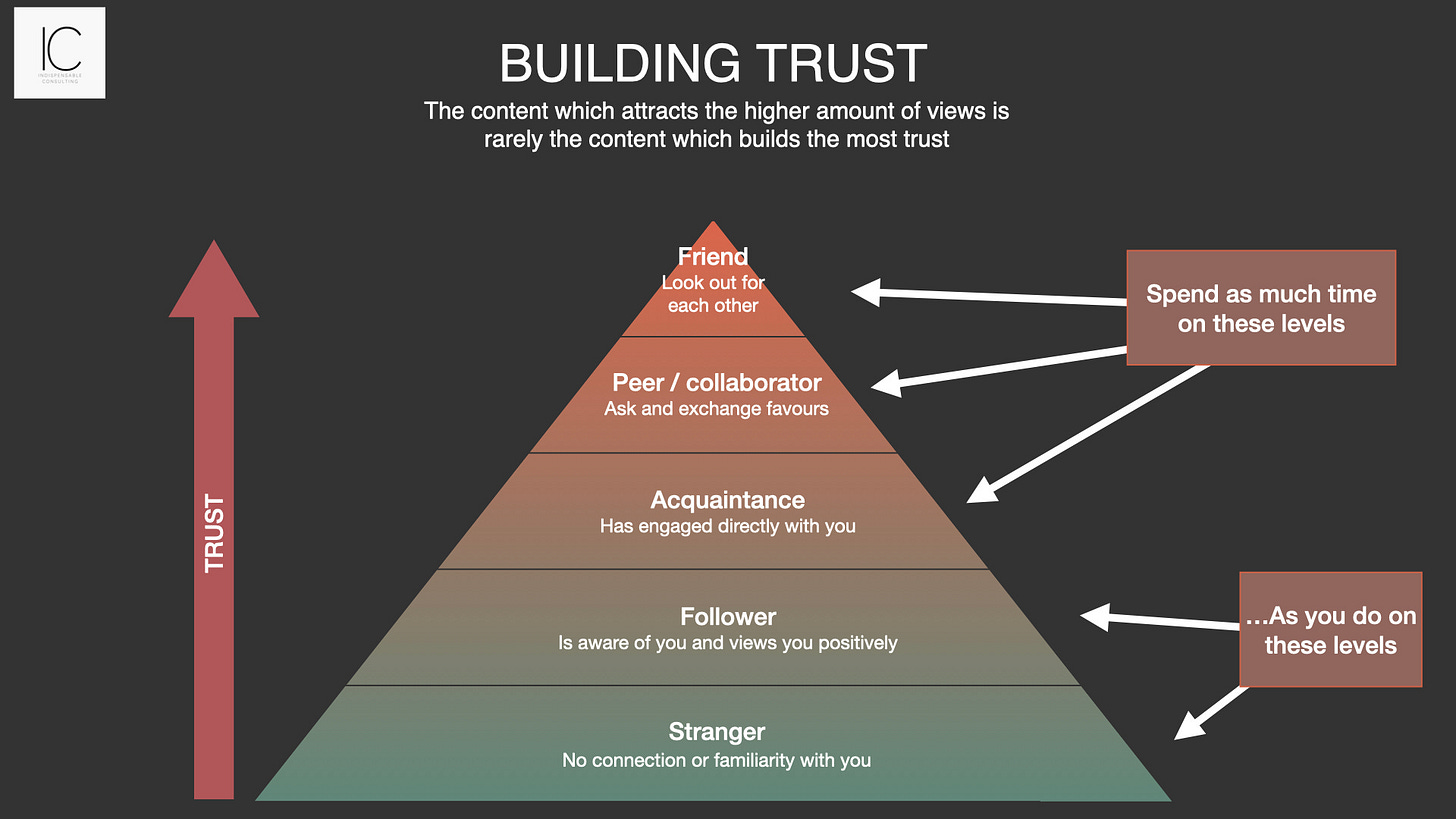You Only Need To Engage 50 People (the magic of Micro ABM)
ABM is a compelling way to attract clients once you've established a strong reputation and track record. Focus on just a handful of people and build strong relationships.
Hi, I’m Rich. Welcome to my weekly newsletter where I share systems and frameworks for scaling your consulting practice from $0 to $1m+ in revenue.
You can get 1:1 personal coaching or explore my course: Proposal Mastery: Learn To Write Winning Business Proposals.
The Best Email I’ve Ever Received
This is probably the best email I’ve received.
You can spot the five things I love about this email.
It’s informal - it’s from someone I’ve known and engaged with for years.
The person understands our USP (we don’t need any persuading.
It’s not a competitive pitch.
They list their budget up front.
They want to connect me with their senior leadership team.
While this is probably the best, it’s not too dissimilar from most of the emails we receive seeking support. Most of the time, when people in our audience need help, they come directly to us rather than shopping around. And that’s a sign that our strategy is working.
It’s because I focus on 50 critical people.
This is the approach that has led me to sign Apple, Alphabet, Microsoft, Meta, SAP, Oracle, HP, Sephora, Amazon, Novartis, Autodesk, United Nations, The World Bank, and many, many more as clients over the past fifteen years.
Focusing On 50 Critical People Is Game-Changing
When you focus on 50 people, it changes your entire marketing approach.
I know exactly who I’m writing content for - the exact few dozen people I want to reach. This lets me pitch it at exactly the right level and even mention those organisations as examples.
Likewise, when I attend events, my goal is to deepen the relationship I have with the 50 critical people on my list.
I know exactly who I want to be speaking to, when I’ll be speaking with them (I schedule meetings beforehand), what I’ll be speaking to them about (this could be a discovery call, how I can help them, proposal review, an upcoming project etc..), and what I want the outcome of these meetings to be.
Beyond The Niche
The standard approach to attracting clients involves selecting a niche, defining your position, and then creating content in hopes that people within that niche will read it and reach out to you.
But that’s a competitive place to be - and relies almost entirely on a degree of chance.
If you publish something and your critical people are on holiday that week, it doesn’t get read. Likewise, the vast majority of senior folks, the kind you want to engage with, don’t read random content from random people unless it’s sent to them by someone they trust.
A far more precise approach is to begin by:
Identifying the list of clients you want to work with (those within your niche).
Identify who within those clients is engaged in the problems you want to solve.
Get yourself on their radar.
Find a way to engage and learn about them.
Build trust and credibility - they must know you can help them.
If you do this right, your approach to selling yourself will be a dozen times better.
I’ve shared how we signed Microsoft using this exact approach in the past.
Step One: Identify The 10 Organisations You Want To Work With
Once you’ve identified your north star, selected your niche, decided what services to offer, and how to package your services, the next step is to go even deeper and list the specific organisations you want to work with.
Whereas before you list a broad market, say “mid-sized SaaS companies in the HR tech space”, now we’re going to build a list of 10 or so companies within that niche you most want to work with (e.g., Guston, BambooHR, Personio, etc.).
You might need to be a little creative in finding these. But you can explore the filters on LinkedIn, industry events/awards, or use ChatGPT if you like.
It helps here if the organisations are relatively similar to one another. Having one client should increase the likelihood of attracting others. That’s because organisations want to work with those like themselves and staff tend to move from one organisation to the next - potentially bringing you with them.
Wait a second, didn’t we want a list of 50 key people?
Why are we only listing 10 organisations? Well, let’s get into that.
Step Two: List Five Key People At Each Organisation
It’s tempting at this point to begin listing who you believe the key decision maker is at each of these organizations and begin engaging with them.
Don’t do that.
They might not be the key decision maker.
They get a LOT of pitches every day - you can’t overcome that.
You will be training them to ignore you.
Instead of rushing to contact the CMO or Managing Partner, begin by building relationships with Tier 1 contacts. These are the people closest to the actual work.
90% of the work I attract is from internal referrals from tier 1 and tier 2 contacts.
These are the people you can more easily build relationships with, gain inside knowledge, and they can act as informal sponsors.
From there, you can move up to Tier 2 (mid-level managers) who have more influence over budgets and strategy. Finally, you approach Tier 3 once you have context, credibility, and ideally an internal referral.
You want to build up a list of 50 people at these 10 organisations. You can see an example (without the names) below).
At this stage, you are not guessing who the ultimate decision-maker is. Instead, you are mapping the ecosystem of people connected to the problems you solve.
Begin with LinkedIn. Search for the company name and filter by relevant job titles from your Tier 1 list (for example, “Marketing Specialist,” “Customer Success,” “E-commerce Associate”). Review their profiles to see what projects they mention, the tools they use, and the teams they are part of. Often you will spot clues about who else is involved, such as someone in a different department tagged in a post or a manager mentioned in their “Experience” section.
Look at industry events and webinars. Many companies send staff to conferences, panel discussions, and virtual summits. Scan speaker lists for names from your target companies, but do not just focus on the big names. A “Customer Success Manager” speaking on a small panel can be a better starting point than the VP on the keynote stage. Event sponsor pages and attendee lists, when public, are goldmines for contact names.
Dig into the project itself if you can. Browse the company’s blog, press releases, or case studies to see what initiatives are active. Is there a new product launch? A big client onboarding? A marketing campaign? These stories often quote or highlight the people leading the charge, and they are exactly the ones you want to talk to first.
Monitor who is talking about the work. On LinkedIn, search for the company name in posts rather than profiles. This surfaces people sharing updates, celebrating milestones, or discussing challenges. You will often find Tier 1 and Tier 2 contacts posting enthusiastically about their role, making them easy to approach.
By piecing together these signals, you can move from a cold, generic outreach to a warm, informed introduction that references their current work and positions you as someone who is already invested in their success.
Step Three: Get Yourself On Their Radar
Now you need to get yourself on their radar
The key is to begin by engaging the people who are easiest to engage - the tier 1 connections. You need to earn trust and gradually transition from strangers to acquaintances, and ideally, to peers/collaborators.
Tier 1: Build Your List Of Junior Contacts At Organisations
The first step is to build your list of contacts at these organisations.
Connect and engage softly on LinkedIn. Find and add the Tier 1 people on LinkedIn. Follow their work, like and share their content where possible, and drop the occasional compliment. Send links to resources they might be interested in - both to your content and the content of others. Leave genuine, thoughtful comments. Your goal is for them to recognise your name tag if they encounter you at an event. Simple familiarity at this stage is key.
Create content or host events for this audience. Now, create the type of content that will appeal specifically to this audience. You can see some examples of this here. A good rule of thumb here is that the content should only be helpful to those in the 10 organizations you want to work with. This is where things like the below can help.
Exclusive events/invitations, etc…
You can find plenty more examples below.

To attract enterprise clients through content, you usually have to do the things others aren’t doing No one else is creating content that’s this targeted. Which is why you will get their attention. Since this audience is familiar with you, you can send them the links directly. You can see how we signed Microsoft as a client following this approach.
Over time, you should be able to have a separate mailing list that contains specifically these individuals who know and are familiar with you. This is the mailing list you spend most of your time on.
By the end of this journey, you should have a lot of tier 1 contacts at the organisations you want to work with. Often, simply these steps will net you a few clients through internal referrals. However, you also want more senior contacts.
Also, don’t forget, many of these junior-level contacts will advance to senior-level positions at these organisations.
This step will get you on the radar of the organisations you want to work with. The next step is to build collaborative relationships.
Step Four: Build Collaborative Relationships
We now aim to establish relationships with key stakeholders. These are typically line-level managers within the organisation. They have influence, manage staff, and often have the authority to hire you themselves without a senior decision-maker.
They are most likely to hear of you through their junior-level staff, but this doesn’t mean you can’t build relationships more directly. The goal here is not to sell, but to create opportunities to be useful and have value.
This might include:
Build trust through collaborations. My favourite thing here is to look for opportunities to collaborate on projects. Perhaps invite them to webinars, participate in an eBook or research report, or create a set of common standards. This not only produces useful material for your audience but also helps build and solidify a relationship.
Research calls. Once I have good relationships with junior people, I often ask if they might be willing to participate in a research call so I can learn more about them and their success so far. I share what I’ve learned, and they share what they’re learning, often leading directly into sales opportunities. They usually invite the more senior person to join them on these calls. I tend to have 1 of these a week.
Be radically generous. Once you understand their needs, share as much helpful advice as possible. Highlight new research or reports they should read (not just from you). Highlight useful examples. Recommend books. And connect them with others they should be associated with. Be someone who is a constant source of help and value.
Ask for help. Don’t be afraid of asking for help, too. Asking for help often leads to the person liking you more (The Benjamin Franklin Effect). If I need suggestions for vendors, staff to recommend, or examples, I’m happy to reach out to the people on my list. And I usually find they’re willing to help me.
Create opportunities for them to shine. Looking back at the speakers I had for my events in 2013 to 2015, I’m in awe that around 60 to 75% of them later became clients. Inviting someone to speak at an event, or even attending an exclusive event, is an easy way to build a relationship with a senior decision-maker.
At this point, you should consider a lot of these folks as acquaintances you can happily speak with at events without them ever worrying they’re going to be harassed about sales.
Step Five: Create Opportunities To Work Together
If you do the above steps well, you will find opportunities that often simply land on your lap. They will identify problems they need help with, and you should be one of the few people they reach out to. If you’re seen as a trusted source of expertise, you should be first in line.
And this leads to the kinds of emails you see above - the sales process is largely complete in this example.
However, other times, you want to take a more direct route and share some of the problems you can help with. This is where, at some point in your relationship with the senior or mid-level decision-makers, you create an entirely tailored email simply saying:
Hi [name],
Last week, [name] mentioned you’re starting to see a significant decline in your call deflection metrics due to the collapse in search traffic. I think he mentioned it as a 35% drop in the past six months.
I’ve spoken with a few other organisations this week who are seeing very similar declines.
This is a bit of a sales email, but we have a methodology to measure off-site deflection (i.e., the value of snippets / AI overviews) and then combine this with the existing calculation to give an accurate value for call deflection.
We’ve tried this with two clients and found it nearly entirely compensates for the decline (and gives a far more accurate measure of deflection).
If you’re ever interested in exploring it, let me know. I think we might be able to work together to solve this problem for you.
This is very close to a message I sent last week.
The key is that it’s entirely personalised to the decision-maker, providing something they need, and is timed with an internal trigger for why they might want to act now.
Also, it’s never too pushy. We’re not demanding anyone do anything or trying to hard sell. We’re simply informing them there is a solution to their problem, and we can help with it.
If you’ve built your relationships well, you should constantly be in the loop for the situations people are dealing with, how others are solving them, and identifying opportunities, and how what you learn from one can help another.
Summary: The Action Steps to Win Enterprise Clients
Identify 10 Dream Organisations
Go beyond the niche and list the specific companies you most want to work with.
Map 50 Key People
Build a tiered list (junior → mid-level → senior) of ~5 contacts per organisation.
Focus first on Tier 1 staff close to the actual work.
Get on Their Radar
Connect on LinkedIn, engage with their content, and share useful resources.
Create content or events aimed specifically at these people.
Build Collaborative Relationships
Offer research calls, co-create content, and invite them to participate in projects.
Be radically generous - share ideas, connections, and opportunities.
Create Opportunities to Work Together
Listen for problems, then share personalised, timely solutions.
Let opportunities come to you through trust, referrals, and credibility.
Good luck!
Connect with Rich
Are you new to the newsletter? Subscribe for free
Follow me on LinkedIn for more insights
Learn to write persuasive business proposals with my Proposal Mastery course.
Get 1 to 1 personal coaching. Get a personal coach to help you grow your consultancy practice. Tackle topics like positioning, client acquisition, delivering exceptional value, industry leaderships, and building the systems to thrive. Hit reply or learn more about my coaching approach.






Good article, Richard